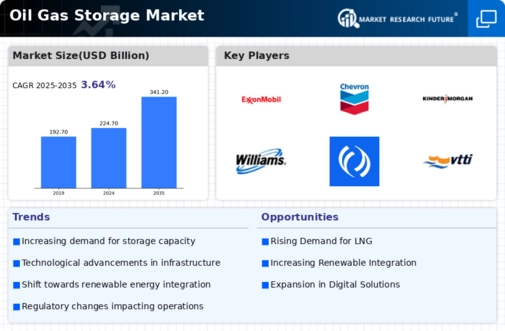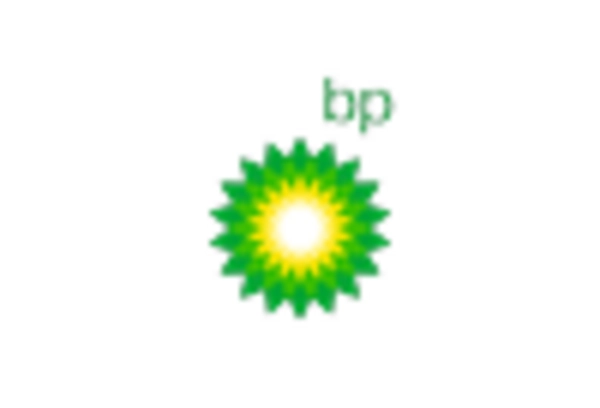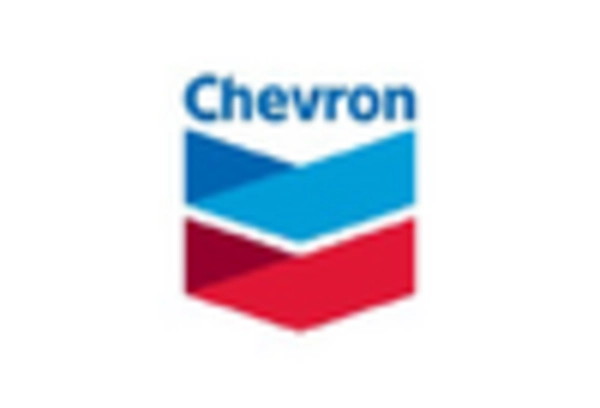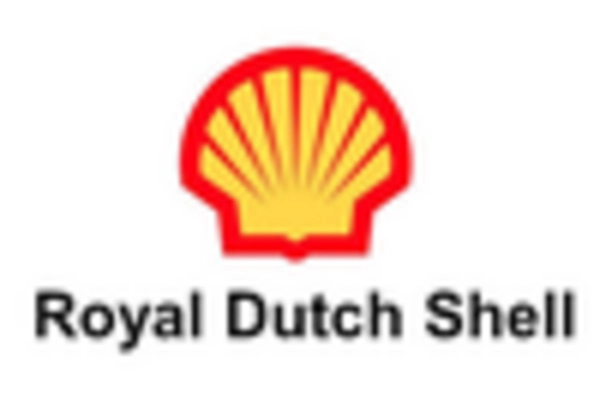-
EXECUTIVE SUMMARY
-
Market Overview
-
Key Findings
-
Market Segmentation
-
Competitive Landscape
-
Challenges and Opportunities
-
Future Outlook
-
MARKET INTRODUCTION
-
Definition
-
Scope of the study
- Research Objective
- Assumption
- Limitations
-
RESEARCH METHODOLOGY
-
Overview
-
Data Mining
-
Secondary Research
-
Primary Research
- Primary Interviews and Information Gathering Process
- Breakdown of Primary Respondents
-
Forecasting Model
-
Market Size Estimation
- Bottom-Up Approach
- Top-Down Approach
-
Data Triangulation
-
Validation
-
MARKET DYNAMICS
-
Overview
-
Drivers
-
Restraints
-
Opportunities
-
MARKET FACTOR ANALYSIS
-
Value chain Analysis
-
Porter's Five Forces Analysis
- Bargaining Power of Suppliers
- Bargaining Power of Buyers
- Threat of New Entrants
- Threat of Substitutes
- Intensity of Rivalry
-
COVID-19 Impact Analysis
- Market Impact Analysis
- Regional Impact
- Opportunity and Threat Analysis
-
OIL GAS STORAGE MARKET, BY STORAGE TYPE (USD BILLION)
-
Above Ground Tanks
-
Below Ground Tanks
-
Floating Storage Units
-
Underground Caverns
-
OIL GAS STORAGE MARKET, BY MATERIAL TYPE (USD BILLION)
-
Steel
-
Plastic
-
Fiber Reinforced Plastic
-
Concrete
-
OIL GAS STORAGE MARKET, BY END USE (USD BILLION)
-
Crude Oil
-
Natural Gas
-
Refined Products
-
Liquefied Natural Gas
-
OIL GAS STORAGE MARKET, BY REGION TYPE (USD BILLION)
-
Commercial Storage
-
Strategic Storage
-
Emergency Storage
-
OIL GAS STORAGE MARKET, BY REGIONAL (USD BILLION)
-
North America
- US
- Canada
-
Europe
- Germany
- UK
- France
- Russia
- Italy
- Spain
- Rest of Europe
-
APAC
- China
- India
- Japan
- South Korea
- Malaysia
- Thailand
- Indonesia
- Rest of APAC
-
South America
- Brazil
- Mexico
- Argentina
- Rest of South America
-
MEA
- GCC Countries
- South Africa
- Rest of MEA
-
COMPETITIVE LANDSCAPE
-
Overview
-
Competitive Analysis
-
Market share Analysis
-
Major Growth Strategy in the Oil Gas Storage Market
-
Competitive Benchmarking
-
Leading Players in Terms of Number of Developments in the Oil Gas Storage Market
-
Key developments and growth strategies
- New Product Launch/Service Deployment
- Merger Acquisitions
- Joint Ventures
-
Major Players Financial Matrix
- Sales and Operating Income
- Major Players RD Expenditure. 2023
-
COMPANY PROFILES
-
ExxonMobil
- Financial Overview
- Products Offered
- Key Developments
- SWOT Analysis
- Key Strategies
-
Chevron
- Financial Overview
- Products Offered
- Key Developments
- SWOT Analysis
- Key Strategies
-
Kinder Morgan
- Financial Overview
- Products Offered
- Key Developments
- SWOT Analysis
- Key Strategies
-
Williams Companies
- Financial Overview
- Products Offered
- Key Developments
- SWOT Analysis
- Key Strategies
-
TC Energy
- Financial Overview
- Products Offered
- Key Developments
- SWOT Analysis
- Key Strategies
-
VTTI
- Financial Overview
- Products Offered
- Key Developments
- SWOT Analysis
- Key Strategies
-
Enbridge
- Financial Overview
- Products Offered
- Key Developments
- SWOT Analysis
- Key Strategies
-
BP
- Financial Overview
- Products Offered
- Key Developments
- SWOT Analysis
- Key Strategies
-
Gibson Energy
- Financial Overview
- Products Offered
- Key Developments
- SWOT Analysis
- Key Strategies
-
TotalEnergies
- Financial Overview
- Products Offered
- Key Developments
- SWOT Analysis
- Key Strategies
-
Oiltanking GmbH
- Financial Overview
- Products Offered
- Key Developments
- SWOT Analysis
- Key Strategies
-
Buckeye Partners
- Financial Overview
- Products Offered
- Key Developments
- SWOT Analysis
- Key Strategies
-
Royal Dutch Shell
- Financial Overview
- Products Offered
- Key Developments
- SWOT Analysis
- Key Strategies
-
Plains All American Pipeline
- Financial Overview
- Products Offered
- Key Developments
- SWOT Analysis
- Key Strategies
-
Magellan Midstream Partners
- Financial Overview
- Products Offered
- Key Developments
- SWOT Analysis
- Key Strategies
-
APPENDIX
-
References
-
Related Reports
-
LIST OF TABLES
-
LIST OF ASSUMPTIONS
-
NORTH AMERICA OIL & GAS STORAGE MARKET SIZE ESTIMATES & FORECAST, BY STORAGE TYPE, 2019-2032 (USD BILLIONS)
-
NORTH AMERICA OIL & GAS STORAGE MARKET SIZE ESTIMATES & FORECAST, BY MATERIAL TYPE, 2019-2032 (USD BILLIONS)
-
NORTH AMERICA OIL & GAS STORAGE MARKET SIZE ESTIMATES & FORECAST, BY END USE, 2019-2032 (USD BILLIONS)
-
NORTH AMERICA OIL & GAS STORAGE MARKET SIZE ESTIMATES & FORECAST, BY REGION TYPE, 2019-2032 (USD BILLIONS)
-
NORTH AMERICA OIL & GAS STORAGE MARKET SIZE ESTIMATES & FORECAST, BY REGIONAL, 2019-2032 (USD BILLIONS)
-
US OIL & GAS STORAGE MARKET SIZE ESTIMATES & FORECAST, BY STORAGE TYPE, 2019-2032 (USD BILLIONS)
-
US OIL & GAS STORAGE MARKET SIZE ESTIMATES & FORECAST, BY MATERIAL TYPE, 2019-2032 (USD BILLIONS)
-
US OIL & GAS STORAGE MARKET SIZE ESTIMATES & FORECAST, BY END USE, 2019-2032 (USD BILLIONS)
-
US OIL & GAS STORAGE MARKET SIZE ESTIMATES & FORECAST, BY REGION TYPE, 2019-2032 (USD BILLIONS)
-
US OIL & GAS STORAGE MARKET SIZE ESTIMATES & FORECAST, BY REGIONAL, 2019-2032 (USD BILLIONS)
-
CANADA OIL & GAS STORAGE MARKET SIZE ESTIMATES & FORECAST, BY STORAGE TYPE, 2019-2032 (USD BILLIONS)
-
CANADA OIL & GAS STORAGE MARKET SIZE ESTIMATES & FORECAST, BY MATERIAL TYPE, 2019-2032 (USD BILLIONS)
-
CANADA OIL & GAS STORAGE MARKET SIZE ESTIMATES & FORECAST, BY END USE, 2019-2032 (USD BILLIONS)
-
CANADA OIL & GAS STORAGE MARKET SIZE ESTIMATES & FORECAST, BY REGION TYPE, 2019-2032 (USD BILLIONS)
-
CANADA OIL & GAS STORAGE MARKET SIZE ESTIMATES & FORECAST, BY REGIONAL, 2019-2032 (USD BILLIONS)
-
EUROPE OIL & GAS STORAGE MARKET SIZE ESTIMATES & FORECAST, BY STORAGE TYPE, 2019-2032 (USD BILLIONS)
-
EUROPE OIL & GAS STORAGE MARKET SIZE ESTIMATES & FORECAST, BY MATERIAL TYPE, 2019-2032 (USD BILLIONS)
-
EUROPE OIL & GAS STORAGE MARKET SIZE ESTIMATES & FORECAST, BY END USE, 2019-2032 (USD BILLIONS)
-
EUROPE OIL & GAS STORAGE MARKET SIZE ESTIMATES & FORECAST, BY REGION TYPE, 2019-2032 (USD BILLIONS)
-
EUROPE OIL & GAS STORAGE MARKET SIZE ESTIMATES & FORECAST, BY REGIONAL, 2019-2032 (USD BILLIONS)
-
GERMANY OIL & GAS STORAGE MARKET SIZE ESTIMATES & FORECAST, BY STORAGE TYPE, 2019-2032 (USD BILLIONS)
-
GERMANY OIL & GAS STORAGE MARKET SIZE ESTIMATES & FORECAST, BY MATERIAL TYPE, 2019-2032 (USD BILLIONS)
-
GERMANY OIL & GAS STORAGE MARKET SIZE ESTIMATES & FORECAST, BY END USE, 2019-2032 (USD BILLIONS)
-
GERMANY OIL & GAS STORAGE MARKET SIZE ESTIMATES & FORECAST, BY REGION TYPE, 2019-2032 (USD BILLIONS)
-
GERMANY OIL & GAS STORAGE MARKET SIZE ESTIMATES & FORECAST, BY REGIONAL, 2019-2032 (USD BILLIONS)
-
UK OIL & GAS STORAGE MARKET SIZE ESTIMATES & FORECAST, BY STORAGE TYPE, 2019-2032 (USD BILLIONS)
-
UK OIL & GAS STORAGE MARKET SIZE ESTIMATES & FORECAST, BY MATERIAL TYPE, 2019-2032 (USD BILLIONS)
-
UK OIL & GAS STORAGE MARKET SIZE ESTIMATES & FORECAST, BY END USE, 2019-2032 (USD BILLIONS)
-
UK OIL & GAS STORAGE MARKET SIZE ESTIMATES & FORECAST, BY REGION TYPE, 2019-2032 (USD BILLIONS)
-
UK OIL & GAS STORAGE MARKET SIZE ESTIMATES & FORECAST, BY REGIONAL, 2019-2032 (USD BILLIONS)
-
FRANCE OIL & GAS STORAGE MARKET SIZE ESTIMATES & FORECAST, BY STORAGE TYPE, 2019-2032 (USD BILLIONS)
-
FRANCE OIL & GAS STORAGE MARKET SIZE ESTIMATES & FORECAST, BY MATERIAL TYPE, 2019-2032 (USD BILLIONS)
-
FRANCE OIL & GAS STORAGE MARKET SIZE ESTIMATES & FORECAST, BY END USE, 2019-2032 (USD BILLIONS)
-
FRANCE OIL & GAS STORAGE MARKET SIZE ESTIMATES & FORECAST, BY REGION TYPE, 2019-2032 (USD BILLIONS)
-
FRANCE OIL & GAS STORAGE MARKET SIZE ESTIMATES & FORECAST, BY REGIONAL, 2019-2032 (USD BILLIONS)
-
RUSSIA OIL & GAS STORAGE MARKET SIZE ESTIMATES & FORECAST, BY STORAGE TYPE, 2019-2032 (USD BILLIONS)
-
RUSSIA OIL & GAS STORAGE MARKET SIZE ESTIMATES & FORECAST, BY MATERIAL TYPE, 2019-2032 (USD BILLIONS)
-
RUSSIA OIL & GAS STORAGE MARKET SIZE ESTIMATES & FORECAST, BY END USE, 2019-2032 (USD BILLIONS)
-
RUSSIA OIL & GAS STORAGE MARKET SIZE ESTIMATES & FORECAST, BY REGION TYPE, 2019-2032 (USD BILLIONS)
-
RUSSIA OIL & GAS STORAGE MARKET SIZE ESTIMATES & FORECAST, BY REGIONAL, 2019-2032 (USD BILLIONS)
-
ITALY OIL & GAS STORAGE MARKET SIZE ESTIMATES & FORECAST, BY STORAGE TYPE, 2019-2032 (USD BILLIONS)
-
ITALY OIL & GAS STORAGE MARKET SIZE ESTIMATES & FORECAST, BY MATERIAL TYPE, 2019-2032 (USD BILLIONS)
-
ITALY OIL & GAS STORAGE MARKET SIZE ESTIMATES & FORECAST, BY END USE, 2019-2032 (USD BILLIONS)
-
ITALY OIL & GAS STORAGE MARKET SIZE ESTIMATES & FORECAST, BY REGION TYPE, 2019-2032 (USD BILLIONS)
-
ITALY OIL & GAS STORAGE MARKET SIZE ESTIMATES & FORECAST, BY REGIONAL, 2019-2032 (USD BILLIONS)
-
SPAIN OIL & GAS STORAGE MARKET SIZE ESTIMATES & FORECAST, BY STORAGE TYPE, 2019-2032 (USD BILLIONS)
-
SPAIN OIL & GAS STORAGE MARKET SIZE ESTIMATES & FORECAST, BY MATERIAL TYPE, 2019-2032 (USD BILLIONS)
-
SPAIN OIL & GAS STORAGE MARKET SIZE ESTIMATES & FORECAST, BY END USE, 2019-2032 (USD BILLIONS)
-
SPAIN OIL & GAS STORAGE MARKET SIZE ESTIMATES & FORECAST, BY REGION TYPE, 2019-2032 (USD BILLIONS)
-
SPAIN OIL & GAS STORAGE MARKET SIZE ESTIMATES & FORECAST, BY REGIONAL, 2019-2032 (USD BILLIONS)
-
REST OF EUROPE OIL & GAS STORAGE MARKET SIZE ESTIMATES & FORECAST, BY STORAGE TYPE, 2019-2032 (USD BILLIONS)
-
REST OF EUROPE OIL & GAS STORAGE MARKET SIZE ESTIMATES & FORECAST, BY MATERIAL TYPE, 2019-2032 (USD BILLIONS)
-
REST OF EUROPE OIL & GAS STORAGE MARKET SIZE ESTIMATES & FORECAST, BY END USE, 2019-2032 (USD BILLIONS)
-
REST OF EUROPE OIL & GAS STORAGE MARKET SIZE ESTIMATES & FORECAST, BY REGION TYPE, 2019-2032 (USD BILLIONS)
-
REST OF EUROPE OIL & GAS STORAGE MARKET SIZE ESTIMATES & FORECAST, BY REGIONAL, 2019-2032 (USD BILLIONS)
-
APAC OIL & GAS STORAGE MARKET SIZE ESTIMATES & FORECAST, BY STORAGE TYPE, 2019-2032 (USD BILLIONS)
-
APAC OIL & GAS STORAGE MARKET SIZE ESTIMATES & FORECAST, BY MATERIAL TYPE, 2019-2032 (USD BILLIONS)
-
APAC OIL & GAS STORAGE MARKET SIZE ESTIMATES & FORECAST, BY END USE, 2019-2032 (USD BILLIONS)
-
APAC OIL & GAS STORAGE MARKET SIZE ESTIMATES & FORECAST, BY REGION TYPE, 2019-2032 (USD BILLIONS)
-
APAC OIL & GAS STORAGE MARKET SIZE ESTIMATES & FORECAST, BY REGIONAL, 2019-2032 (USD BILLIONS)
-
CHINA OIL & GAS STORAGE MARKET SIZE ESTIMATES & FORECAST, BY STORAGE TYPE, 2019-2032 (USD BILLIONS)
-
CHINA OIL & GAS STORAGE MARKET SIZE ESTIMATES & FORECAST, BY MATERIAL TYPE, 2019-2032 (USD BILLIONS)
-
CHINA OIL & GAS STORAGE MARKET SIZE ESTIMATES & FORECAST, BY END USE, 2019-2032 (USD BILLIONS)
-
CHINA OIL & GAS STORAGE MARKET SIZE ESTIMATES & FORECAST, BY REGION TYPE, 2019-2032 (USD BILLIONS)
-
CHINA OIL & GAS STORAGE MARKET SIZE ESTIMATES & FORECAST, BY REGIONAL, 2019-2032 (USD BILLIONS)
-
INDIA OIL & GAS STORAGE MARKET SIZE ESTIMATES & FORECAST, BY STORAGE TYPE, 2019-2032 (USD BILLIONS)
-
INDIA OIL & GAS STORAGE MARKET SIZE ESTIMATES & FORECAST, BY MATERIAL TYPE, 2019-2032 (USD BILLIONS)
-
INDIA OIL & GAS STORAGE MARKET SIZE ESTIMATES & FORECAST, BY END USE, 2019-2032 (USD BILLIONS)
-
INDIA OIL & GAS STORAGE MARKET SIZE ESTIMATES & FORECAST, BY REGION TYPE, 2019-2032 (USD BILLIONS)
-
INDIA OIL & GAS STORAGE MARKET SIZE ESTIMATES & FORECAST, BY REGIONAL, 2019-2032 (USD BILLIONS)
-
JAPAN OIL & GAS STORAGE MARKET SIZE ESTIMATES & FORECAST, BY STORAGE TYPE, 2019-2032 (USD BILLIONS)
-
JAPAN OIL & GAS STORAGE MARKET SIZE ESTIMATES & FORECAST, BY MATERIAL TYPE, 2019-2032 (USD BILLIONS)
-
JAPAN OIL & GAS STORAGE MARKET SIZE ESTIMATES & FORECAST, BY END USE, 2019-2032 (USD BILLIONS)
-
JAPAN OIL & GAS STORAGE MARKET SIZE ESTIMATES & FORECAST, BY REGION TYPE, 2019-2032 (USD BILLIONS)
-
JAPAN OIL & GAS STORAGE MARKET SIZE ESTIMATES & FORECAST, BY REGIONAL, 2019-2032 (USD BILLIONS)
-
SOUTH KOREA OIL & GAS STORAGE MARKET SIZE ESTIMATES & FORECAST, BY STORAGE TYPE, 2019-2032 (USD BILLIONS)
-
SOUTH KOREA OIL & GAS STORAGE MARKET SIZE ESTIMATES & FORECAST, BY MATERIAL TYPE, 2019-2032 (USD BILLIONS)
-
SOUTH KOREA OIL & GAS STORAGE MARKET SIZE ESTIMATES & FORECAST, BY END USE, 2019-2032 (USD BILLIONS)
-
SOUTH KOREA OIL & GAS STORAGE MARKET SIZE ESTIMATES & FORECAST, BY REGION TYPE, 2019-2032 (USD BILLIONS)
-
SOUTH KOREA OIL & GAS STORAGE MARKET SIZE ESTIMATES & FORECAST, BY REGIONAL, 2019-2032 (USD BILLIONS)
-
MALAYSIA OIL & GAS STORAGE MARKET SIZE ESTIMATES & FORECAST, BY STORAGE TYPE, 2019-2032 (USD BILLIONS)
-
MALAYSIA OIL & GAS STORAGE MARKET SIZE ESTIMATES & FORECAST, BY MATERIAL TYPE, 2019-2032 (USD BILLIONS)
-
MALAYSIA OIL & GAS STORAGE MARKET SIZE ESTIMATES & FORECAST, BY END USE, 2019-2032 (USD BILLIONS)
-
MALAYSIA OIL & GAS STORAGE MARKET SIZE ESTIMATES & FORECAST, BY REGION TYPE, 2019-2032 (USD BILLIONS)
-
MALAYSIA OIL & GAS STORAGE MARKET SIZE ESTIMATES & FORECAST, BY REGIONAL, 2019-2032 (USD BILLIONS)
-
THAILAND OIL & GAS STORAGE MARKET SIZE ESTIMATES & FORECAST, BY STORAGE TYPE, 2019-2032 (USD BILLIONS)
-
THAILAND OIL & GAS STORAGE MARKET SIZE ESTIMATES & FORECAST, BY MATERIAL TYPE, 2019-2032 (USD BILLIONS)
-
THAILAND OIL & GAS STORAGE MARKET SIZE ESTIMATES & FORECAST, BY END USE, 2019-2032 (USD BILLIONS)
-
THAILAND OIL & GAS STORAGE MARKET SIZE ESTIMATES & FORECAST, BY REGION TYPE, 2019-2032 (USD BILLIONS)
-
THAILAND OIL & GAS STORAGE MARKET SIZE ESTIMATES & FORECAST, BY REGIONAL, 2019-2032 (USD BILLIONS)
-
INDONESIA OIL & GAS STORAGE MARKET SIZE ESTIMATES & FORECAST, BY STORAGE TYPE, 2019-2032 (USD BILLIONS)
-
INDONESIA OIL & GAS STORAGE MARKET SIZE ESTIMATES & FORECAST, BY MATERIAL TYPE, 2019-2032 (USD BILLIONS)
-
INDONESIA OIL & GAS STORAGE MARKET SIZE ESTIMATES & FORECAST, BY END USE, 2019-2032 (USD BILLIONS)
-
INDONESIA OIL & GAS STORAGE MARKET SIZE ESTIMATES & FORECAST, BY REGION TYPE, 2019-2032 (USD BILLIONS)
-
INDONESIA OIL & GAS STORAGE MARKET SIZE ESTIMATES & FORECAST, BY REGIONAL, 2019-2032 (USD BILLIONS)
-
REST OF APAC OIL & GAS STORAGE MARKET SIZE ESTIMATES & FORECAST, BY STORAGE TYPE, 2019-2032 (USD BILLIONS)
-
REST OF APAC OIL & GAS STORAGE MARKET SIZE ESTIMATES & FORECAST, BY MATERIAL TYPE, 2019-2032 (USD BILLIONS)
-
REST OF APAC OIL & GAS STORAGE MARKET SIZE ESTIMATES & FORECAST, BY END USE, 2019-2032 (USD BILLIONS)
-
REST OF APAC OIL & GAS STORAGE MARKET SIZE ESTIMATES & FORECAST, BY REGION TYPE, 2019-2032 (USD BILLIONS)
-
REST OF APAC OIL & GAS STORAGE MARKET SIZE ESTIMATES & FORECAST, BY REGIONAL, 2019-2032 (USD BILLIONS)
-
SOUTH AMERICA OIL & GAS STORAGE MARKET SIZE ESTIMATES & FORECAST, BY STORAGE TYPE, 2019-2032 (USD BILLIONS)
-
SOUTH AMERICA OIL & GAS STORAGE MARKET SIZE ESTIMATES & FORECAST, BY MATERIAL TYPE, 2019-2032 (USD BILLIONS)
-
SOUTH AMERICA OIL & GAS STORAGE MARKET SIZE ESTIMATES & FORECAST, BY END USE, 2019-2032 (USD BILLIONS)
-
SOUTH AMERICA OIL & GAS STORAGE MARKET SIZE ESTIMATES & FORECAST, BY REGION TYPE, 2019-2032 (USD BILLIONS)
-
SOUTH AMERICA OIL & GAS STORAGE MARKET SIZE ESTIMATES & FORECAST, BY REGIONAL, 2019-2032 (USD BILLIONS)
-
BRAZIL OIL & GAS STORAGE MARKET SIZE ESTIMATES & FORECAST, BY STORAGE TYPE, 2019-2032 (USD BILLIONS)
-
BRAZIL OIL & GAS STORAGE MARKET SIZE ESTIMATES & FORECAST, BY MATERIAL TYPE, 2019-2032 (USD BILLIONS)
-
BRAZIL OIL & GAS STORAGE MARKET SIZE ESTIMATES & FORECAST, BY END USE, 2019-2032 (USD BILLIONS)
-
BRAZIL OIL & GAS STORAGE MARKET SIZE ESTIMATES & FORECAST, BY REGION TYPE, 2019-2032 (USD BILLIONS)
-
BRAZIL OIL & GAS STORAGE MARKET SIZE ESTIMATES & FORECAST, BY REGIONAL, 2019-2032 (USD BILLIONS)
-
MEXICO OIL & GAS STORAGE MARKET SIZE ESTIMATES & FORECAST, BY STORAGE TYPE, 2019-2032 (USD BILLIONS)
-
MEXICO OIL & GAS STORAGE MARKET SIZE ESTIMATES & FORECAST, BY MATERIAL TYPE, 2019-2032 (USD BILLIONS)
-
MEXICO OIL & GAS STORAGE MARKET SIZE ESTIMATES & FORECAST, BY END USE, 2019-2032 (USD BILLIONS)
-
MEXICO OIL & GAS STORAGE MARKET SIZE ESTIMATES & FORECAST, BY REGION TYPE, 2019-2032 (USD BILLIONS)
-
MEXICO OIL & GAS STORAGE MARKET SIZE ESTIMATES & FORECAST, BY REGIONAL, 2019-2032 (USD BILLIONS)
-
ARGENTINA OIL & GAS STORAGE MARKET SIZE ESTIMATES & FORECAST, BY STORAGE TYPE, 2019-2032 (USD BILLIONS)
-
ARGENTINA OIL & GAS STORAGE MARKET SIZE ESTIMATES & FORECAST, BY MATERIAL TYPE, 2019-2032 (USD BILLIONS)
-
ARGENTINA OIL & GAS STORAGE MARKET SIZE ESTIMATES & FORECAST, BY END USE, 2019-2032 (USD BILLIONS)
-
ARGENTINA OIL & GAS STORAGE MARKET SIZE ESTIMATES & FORECAST, BY REGION TYPE, 2019-2032 (USD BILLIONS)
-
ARGENTINA OIL & GAS STORAGE MARKET SIZE ESTIMATES & FORECAST, BY REGIONAL, 2019-2032 (USD BILLIONS)
-
REST OF SOUTH AMERICA OIL & GAS STORAGE MARKET SIZE ESTIMATES & FORECAST, BY STORAGE TYPE, 2019-2032 (USD BILLIONS)
-
REST OF SOUTH AMERICA OIL & GAS STORAGE MARKET SIZE ESTIMATES & FORECAST, BY MATERIAL TYPE, 2019-2032 (USD BILLIONS)
-
REST OF SOUTH AMERICA OIL & GAS STORAGE MARKET SIZE ESTIMATES & FORECAST, BY END USE, 2019-2032 (USD BILLIONS)
-
REST OF SOUTH AMERICA OIL & GAS STORAGE MARKET SIZE ESTIMATES & FORECAST, BY REGION TYPE, 2019-2032 (USD BILLIONS)
-
REST OF SOUTH AMERICA OIL & GAS STORAGE MARKET SIZE ESTIMATES & FORECAST, BY REGIONAL, 2019-2032 (USD BILLIONS)
-
MEA OIL & GAS STORAGE MARKET SIZE ESTIMATES & FORECAST, BY STORAGE TYPE, 2019-2032 (USD BILLIONS)
-
MEA OIL & GAS STORAGE MARKET SIZE ESTIMATES & FORECAST, BY MATERIAL TYPE, 2019-2032 (USD BILLIONS)
-
MEA OIL & GAS STORAGE MARKET SIZE ESTIMATES & FORECAST, BY END USE, 2019-2032 (USD BILLIONS)
-
MEA OIL & GAS STORAGE MARKET SIZE ESTIMATES & FORECAST, BY REGION TYPE, 2019-2032 (USD BILLIONS)
-
MEA OIL & GAS STORAGE MARKET SIZE ESTIMATES & FORECAST, BY REGIONAL, 2019-2032 (USD BILLIONS)
-
GCC COUNTRIES OIL & GAS STORAGE MARKET SIZE ESTIMATES & FORECAST, BY STORAGE TYPE, 2019-2032 (USD BILLIONS)
-
GCC COUNTRIES OIL & GAS STORAGE MARKET SIZE ESTIMATES & FORECAST, BY MATERIAL TYPE, 2019-2032 (USD BILLIONS)
-
GCC COUNTRIES OIL & GAS STORAGE MARKET SIZE ESTIMATES & FORECAST, BY END USE, 2019-2032 (USD BILLIONS)
-
GCC COUNTRIES OIL & GAS STORAGE MARKET SIZE ESTIMATES & FORECAST, BY REGION TYPE, 2019-2032 (USD BILLIONS)
-
GCC COUNTRIES OIL & GAS STORAGE MARKET SIZE ESTIMATES & FORECAST, BY REGIONAL, 2019-2032 (USD BILLIONS)
-
SOUTH AFRICA OIL & GAS STORAGE MARKET SIZE ESTIMATES & FORECAST, BY STORAGE TYPE, 2019-2032 (USD BILLIONS)
-
SOUTH AFRICA OIL & GAS STORAGE MARKET SIZE ESTIMATES & FORECAST, BY MATERIAL TYPE, 2019-2032 (USD BILLIONS)
-
SOUTH AFRICA OIL & GAS STORAGE MARKET SIZE ESTIMATES & FORECAST, BY END USE, 2019-2032 (USD BILLIONS)
-
SOUTH AFRICA OIL & GAS STORAGE MARKET SIZE ESTIMATES & FORECAST, BY REGION TYPE, 2019-2032 (USD BILLIONS)
-
SOUTH AFRICA OIL & GAS STORAGE MARKET SIZE ESTIMATES & FORECAST, BY REGIONAL, 2019-2032 (USD BILLIONS)
-
REST OF MEA OIL & GAS STORAGE MARKET SIZE ESTIMATES & FORECAST, BY STORAGE TYPE, 2019-2032 (USD BILLIONS)
-
REST OF MEA OIL & GAS STORAGE MARKET SIZE ESTIMATES & FORECAST, BY MATERIAL TYPE, 2019-2032 (USD BILLIONS)
-
REST OF MEA OIL & GAS STORAGE MARKET SIZE ESTIMATES & FORECAST, BY END USE, 2019-2032 (USD BILLIONS)
-
REST OF MEA OIL & GAS STORAGE MARKET SIZE ESTIMATES & FORECAST, BY REGION TYPE, 2019-2032 (USD BILLIONS)
-
REST OF MEA OIL & GAS STORAGE MARKET SIZE ESTIMATES & FORECAST, BY REGIONAL, 2019-2032 (USD BILLIONS)
-
PRODUCT LAUNCH/PRODUCT DEVELOPMENT/APPROVAL
-
ACQUISITION/PARTNERSHIP
-
LIST OF FIGURES
-
MARKET SYNOPSIS
-
NORTH AMERICA OIL & GAS STORAGE MARKET ANALYSIS
-
US OIL & GAS STORAGE MARKET ANALYSIS BY STORAGE TYPE
-
US OIL & GAS STORAGE MARKET ANALYSIS BY MATERIAL TYPE
-
US OIL & GAS STORAGE MARKET ANALYSIS BY END USE
-
US OIL & GAS STORAGE MARKET ANALYSIS BY REGION TYPE
-
US OIL & GAS STORAGE MARKET ANALYSIS BY REGIONAL
-
CANADA OIL & GAS STORAGE MARKET ANALYSIS BY STORAGE TYPE
-
CANADA OIL & GAS STORAGE MARKET ANALYSIS BY MATERIAL TYPE
-
CANADA OIL & GAS STORAGE MARKET ANALYSIS BY END USE
-
CANADA OIL & GAS STORAGE MARKET ANALYSIS BY REGION TYPE
-
CANADA OIL & GAS STORAGE MARKET ANALYSIS BY REGIONAL
-
EUROPE OIL & GAS STORAGE MARKET ANALYSIS
-
GERMANY OIL & GAS STORAGE MARKET ANALYSIS BY STORAGE TYPE
-
GERMANY OIL & GAS STORAGE MARKET ANALYSIS BY MATERIAL TYPE
-
GERMANY OIL & GAS STORAGE MARKET ANALYSIS BY END USE
-
GERMANY OIL & GAS STORAGE MARKET ANALYSIS BY REGION TYPE
-
GERMANY OIL & GAS STORAGE MARKET ANALYSIS BY REGIONAL
-
UK OIL & GAS STORAGE MARKET ANALYSIS BY STORAGE TYPE
-
UK OIL & GAS STORAGE MARKET ANALYSIS BY MATERIAL TYPE
-
UK OIL & GAS STORAGE MARKET ANALYSIS BY END USE
-
UK OIL & GAS STORAGE MARKET ANALYSIS BY REGION TYPE
-
UK OIL & GAS STORAGE MARKET ANALYSIS BY REGIONAL
-
FRANCE OIL & GAS STORAGE MARKET ANALYSIS BY STORAGE TYPE
-
FRANCE OIL & GAS STORAGE MARKET ANALYSIS BY MATERIAL TYPE
-
FRANCE OIL & GAS STORAGE MARKET ANALYSIS BY END USE
-
FRANCE OIL & GAS STORAGE MARKET ANALYSIS BY REGION TYPE
-
FRANCE OIL & GAS STORAGE MARKET ANALYSIS BY REGIONAL
-
RUSSIA OIL & GAS STORAGE MARKET ANALYSIS BY STORAGE TYPE
-
RUSSIA OIL & GAS STORAGE MARKET ANALYSIS BY MATERIAL TYPE
-
RUSSIA OIL & GAS STORAGE MARKET ANALYSIS BY END USE
-
RUSSIA OIL & GAS STORAGE MARKET ANALYSIS BY REGION TYPE
-
RUSSIA OIL & GAS STORAGE MARKET ANALYSIS BY REGIONAL
-
ITALY OIL & GAS STORAGE MARKET ANALYSIS BY STORAGE TYPE
-
ITALY OIL & GAS STORAGE MARKET ANALYSIS BY MATERIAL TYPE
-
ITALY OIL & GAS STORAGE MARKET ANALYSIS BY END USE
-
ITALY OIL & GAS STORAGE MARKET ANALYSIS BY REGION TYPE
-
ITALY OIL & GAS STORAGE MARKET ANALYSIS BY REGIONAL
-
SPAIN OIL & GAS STORAGE MARKET ANALYSIS BY STORAGE TYPE
-
SPAIN OIL & GAS STORAGE MARKET ANALYSIS BY MATERIAL TYPE
-
SPAIN OIL & GAS STORAGE MARKET ANALYSIS BY END USE
-
SPAIN OIL & GAS STORAGE MARKET ANALYSIS BY REGION TYPE
-
SPAIN OIL & GAS STORAGE MARKET ANALYSIS BY REGIONAL
-
REST OF EUROPE OIL & GAS STORAGE MARKET ANALYSIS BY STORAGE TYPE
-
REST OF EUROPE OIL & GAS STORAGE MARKET ANALYSIS BY MATERIAL TYPE
-
REST OF EUROPE OIL & GAS STORAGE MARKET ANALYSIS BY END USE
-
REST OF EUROPE OIL & GAS STORAGE MARKET ANALYSIS BY REGION TYPE
-
REST OF EUROPE OIL & GAS STORAGE MARKET ANALYSIS BY REGIONAL
-
APAC OIL & GAS STORAGE MARKET ANALYSIS
-
CHINA OIL & GAS STORAGE MARKET ANALYSIS BY STORAGE TYPE
-
CHINA OIL & GAS STORAGE MARKET ANALYSIS BY MATERIAL TYPE
-
CHINA OIL & GAS STORAGE MARKET ANALYSIS BY END USE
-
CHINA OIL & GAS STORAGE MARKET ANALYSIS BY REGION TYPE
-
CHINA OIL & GAS STORAGE MARKET ANALYSIS BY REGIONAL
-
INDIA OIL & GAS STORAGE MARKET ANALYSIS BY STORAGE TYPE
-
INDIA OIL & GAS STORAGE MARKET ANALYSIS BY MATERIAL TYPE
-
INDIA OIL & GAS STORAGE MARKET ANALYSIS BY END USE
-
INDIA OIL & GAS STORAGE MARKET ANALYSIS BY REGION TYPE
-
INDIA OIL & GAS STORAGE MARKET ANALYSIS BY REGIONAL
-
JAPAN OIL & GAS STORAGE MARKET ANALYSIS BY STORAGE TYPE
-
JAPAN OIL & GAS STORAGE MARKET ANALYSIS BY MATERIAL TYPE
-
JAPAN OIL & GAS STORAGE MARKET ANALYSIS BY END USE
-
JAPAN OIL & GAS STORAGE MARKET ANALYSIS BY REGION TYPE
-
JAPAN OIL & GAS STORAGE MARKET ANALYSIS BY REGIONAL
-
SOUTH KOREA OIL & GAS STORAGE MARKET ANALYSIS BY STORAGE TYPE
-
SOUTH KOREA OIL & GAS STORAGE MARKET ANALYSIS BY MATERIAL TYPE
-
SOUTH KOREA OIL & GAS STORAGE MARKET ANALYSIS BY END USE
-
SOUTH KOREA OIL & GAS STORAGE MARKET ANALYSIS BY REGION TYPE
-
SOUTH KOREA OIL & GAS STORAGE MARKET ANALYSIS BY REGIONAL
-
MALAYSIA OIL & GAS STORAGE MARKET ANALYSIS BY STORAGE TYPE
-
MALAYSIA OIL & GAS STORAGE MARKET ANALYSIS BY MATERIAL TYPE
-
MALAYSIA OIL & GAS STORAGE MARKET ANALYSIS BY END USE
-
MALAYSIA OIL & GAS STORAGE MARKET ANALYSIS BY REGION TYPE
-
MALAYSIA OIL & GAS STORAGE MARKET ANALYSIS BY REGIONAL
-
THAILAND OIL & GAS STORAGE MARKET ANALYSIS BY STORAGE TYPE
-
THAILAND OIL & GAS STORAGE MARKET ANALYSIS BY MATERIAL TYPE
-
THAILAND OIL & GAS STORAGE MARKET ANALYSIS BY END USE
-
THAILAND OIL & GAS STORAGE MARKET ANALYSIS BY REGION TYPE
-
THAILAND OIL & GAS STORAGE MARKET ANALYSIS BY REGIONAL
-
INDONESIA OIL & GAS STORAGE MARKET ANALYSIS BY STORAGE TYPE
-
INDONESIA OIL & GAS STORAGE MARKET ANALYSIS BY MATERIAL TYPE
-
INDONESIA OIL & GAS STORAGE MARKET ANALYSIS BY END USE
-
INDONESIA OIL & GAS STORAGE MARKET ANALYSIS BY REGION TYPE
-
INDONESIA OIL & GAS STORAGE MARKET ANALYSIS BY REGIONAL
-
REST OF APAC OIL & GAS STORAGE MARKET ANALYSIS BY STORAGE TYPE
-
REST OF APAC OIL & GAS STORAGE MARKET ANALYSIS BY MATERIAL TYPE
-
REST OF APAC OIL & GAS STORAGE MARKET ANALYSIS BY END USE
-
REST OF APAC OIL & GAS STORAGE MARKET ANALYSIS BY REGION TYPE
-
REST OF APAC OIL & GAS STORAGE MARKET ANALYSIS BY REGIONAL
-
SOUTH AMERICA OIL & GAS STORAGE MARKET ANALYSIS
-
BRAZIL OIL & GAS STORAGE MARKET ANALYSIS BY STORAGE TYPE
-
BRAZIL OIL & GAS STORAGE MARKET ANALYSIS BY MATERIAL TYPE
-
BRAZIL OIL & GAS STORAGE MARKET ANALYSIS BY END USE
-
BRAZIL OIL & GAS STORAGE MARKET ANALYSIS BY REGION TYPE
-
BRAZIL OIL & GAS STORAGE MARKET ANALYSIS BY REGIONAL
-
MEXICO OIL & GAS STORAGE MARKET ANALYSIS BY STORAGE TYPE
-
MEXICO OIL & GAS STORAGE MARKET ANALYSIS BY MATERIAL TYPE
-
MEXICO OIL & GAS STORAGE MARKET ANALYSIS BY END USE
-
MEXICO OIL & GAS STORAGE MARKET ANALYSIS BY REGION TYPE
-
MEXICO OIL & GAS STORAGE MARKET ANALYSIS BY REGIONAL
-
ARGENTINA OIL & GAS STORAGE MARKET ANALYSIS BY STORAGE TYPE
-
ARGENTINA OIL & GAS STORAGE MARKET ANALYSIS BY MATERIAL TYPE
-
ARGENTINA OIL & GAS STORAGE MARKET ANALYSIS BY END USE
-
ARGENTINA OIL & GAS STORAGE MARKET ANALYSIS BY REGION TYPE
-
ARGENTINA OIL &

















Leave a Comment